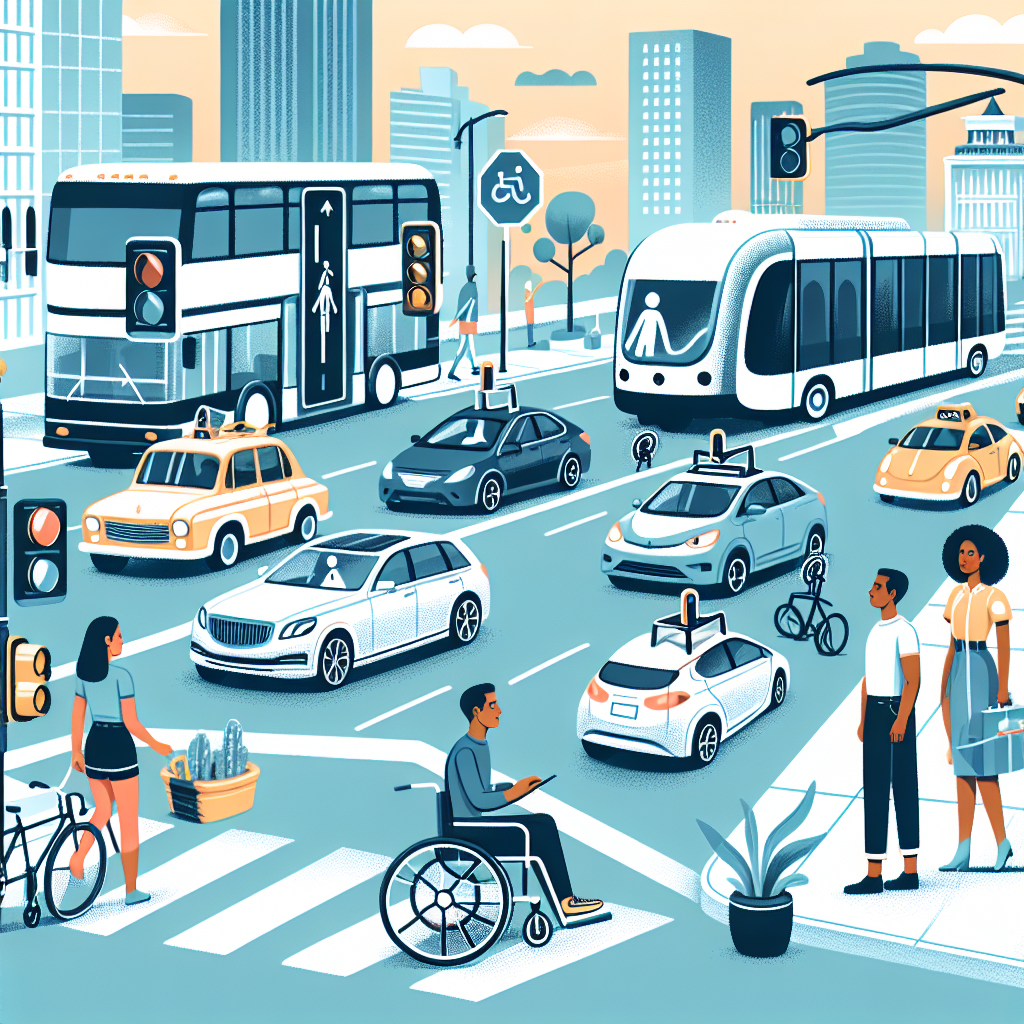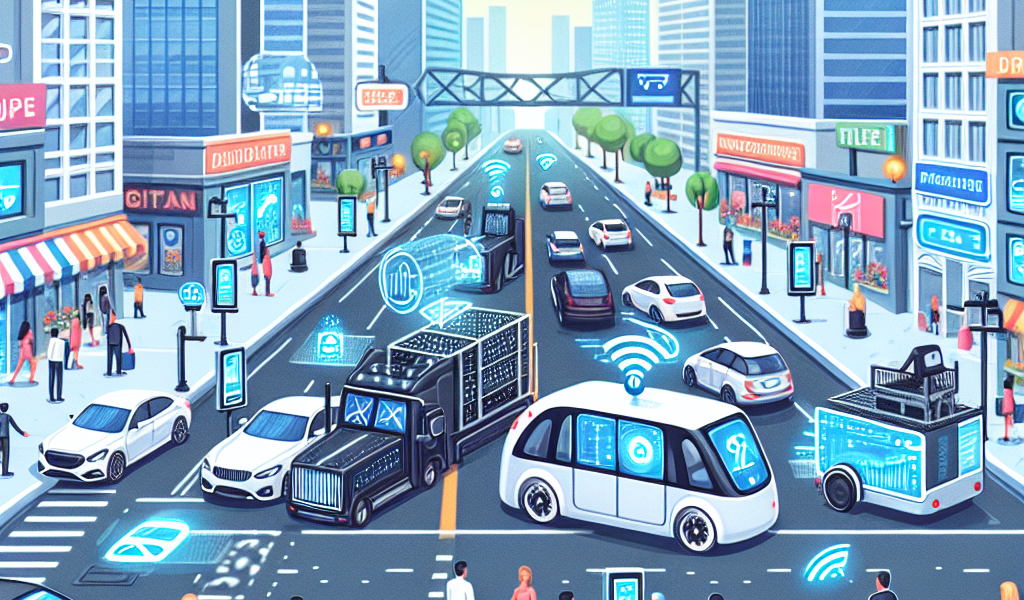-
Table of Contents
“Revolutionizing Mobility: Autonomous Vehicles Drive the Future of Transportation”
Introduction

Autonomous vehicles, often referred to as self-driving cars, are revolutionizing the transportation industry by introducing unprecedented levels of safety, efficiency, and convenience. These vehicles utilize advanced technologies such as artificial intelligence, machine learning, and an array of sensors to navigate and operate without human intervention. The integration of autonomous vehicles promises to reduce traffic accidents caused by human error, optimize traffic flow, and decrease congestion. Additionally, they offer significant potential for cost savings in logistics and public transportation, while also providing mobility solutions for individuals unable to drive. As the technology continues to evolve, autonomous vehicles are poised to transform urban planning, environmental sustainability, and the overall landscape of transportation.
Enhancing Road Safety with Autonomous Vehicles
Autonomous vehicles, often referred to as self-driving cars, are revolutionizing the transportation industry in numerous ways. One of the most significant impacts of this technological advancement is the enhancement of road safety. As these vehicles become more prevalent, their potential to reduce accidents and save lives is becoming increasingly evident.
To begin with, autonomous vehicles are equipped with an array of sensors, cameras, and advanced algorithms that allow them to perceive their surroundings with a level of precision that far surpasses human capabilities. These systems can detect obstacles, recognize traffic signals, and anticipate the actions of other road users in real-time. Consequently, the likelihood of human error, which is a leading cause of traffic accidents, is significantly diminished. For instance, distracted driving, impaired driving, and fatigue-related incidents are virtually eliminated when the vehicle is in control.
Moreover, autonomous vehicles are programmed to adhere strictly to traffic laws and regulations. They maintain appropriate speeds, follow safe distances, and execute maneuvers with precision. This adherence to rules not only reduces the risk of accidents but also promotes a more orderly flow of traffic. In contrast, human drivers often exhibit unpredictable behavior, such as sudden lane changes or aggressive driving, which can lead to collisions. By removing these variables, autonomous vehicles contribute to a safer driving environment.
In addition to their advanced perception and adherence to traffic laws, autonomous vehicles are capable of communicating with each other through vehicle-to-vehicle (V2V) technology. This communication allows them to share information about their speed, position, and intended actions. As a result, they can coordinate their movements to avoid potential conflicts and optimize traffic flow. For example, if one vehicle detects an obstacle on the road, it can instantly relay this information to nearby vehicles, enabling them to adjust their routes accordingly. This level of coordination is unattainable with human drivers and represents a significant leap forward in road safety.
Furthermore, the integration of autonomous vehicles into the transportation system has the potential to reduce the severity of accidents when they do occur. These vehicles are designed with advanced safety features, such as automatic emergency braking and collision avoidance systems, which can mitigate the impact of a crash. In many cases, these systems can prevent accidents altogether by taking evasive action when a collision is imminent. This proactive approach to safety is a stark contrast to the reactive nature of human drivers, who often have limited time to respond to sudden hazards.
While the benefits of autonomous vehicles in enhancing road safety are clear, it is important to acknowledge the challenges that remain. Ensuring the reliability and security of the technology is paramount, as any malfunction or cyber-attack could have serious consequences. Additionally, the transition to a fully autonomous transportation system will require significant infrastructure upgrades and regulatory changes. However, the potential rewards in terms of lives saved and injuries prevented make these challenges worth addressing.
In conclusion, autonomous vehicles are poised to transform the transportation industry by significantly enhancing road safety. Through their advanced perception capabilities, strict adherence to traffic laws, and ability to communicate with each other, these vehicles can reduce the incidence and severity of accidents. While challenges remain, the promise of a safer driving environment is a compelling reason to continue advancing this technology. As autonomous vehicles become more integrated into our daily lives, the roads of the future may indeed be much safer than those of today.
Reducing Traffic Congestion Through Self-Driving Technology
Autonomous vehicles are poised to revolutionize the transportation industry, and one of the most significant impacts is their potential to reduce traffic congestion. As urban areas continue to grow and the number of vehicles on the road increases, traffic congestion has become a pressing issue, leading to longer commute times, increased fuel consumption, and higher levels of pollution. Self-driving technology offers a promising solution to these challenges by optimizing traffic flow and improving overall efficiency.
One of the primary ways autonomous vehicles can alleviate traffic congestion is through their ability to communicate with each other and with traffic management systems. Unlike human drivers, who often make unpredictable decisions and are prone to errors, self-driving cars can share real-time data about their speed, location, and intended route. This interconnectedness allows for more coordinated and efficient movement of vehicles, reducing the stop-and-go traffic that typically characterizes congested areas. For instance, when a self-driving car detects a slowdown ahead, it can adjust its speed accordingly and relay this information to other autonomous vehicles, enabling a smoother flow of traffic.
Moreover, autonomous vehicles are equipped with advanced sensors and algorithms that allow them to anticipate and react to changing traffic conditions more quickly than human drivers. This capability is particularly beneficial in mitigating the effects of sudden traffic disruptions, such as accidents or roadwork. By rerouting themselves and other vehicles in real-time, self-driving cars can help prevent bottlenecks and ensure that traffic continues to move efficiently. Additionally, the precision with which autonomous vehicles can navigate allows for more effective use of road space, potentially increasing the capacity of existing infrastructure without the need for costly expansions.
Another significant advantage of self-driving technology is its potential to reduce the number of accidents caused by human error, which is a major contributor to traffic congestion. According to the National Highway Traffic Safety Administration, human error is a factor in 94% of all traffic accidents. Autonomous vehicles, with their ability to maintain safe following distances, adhere to speed limits, and avoid distractions, can significantly decrease the likelihood of collisions. Fewer accidents mean fewer traffic jams, as well as reduced strain on emergency services and lower overall costs associated with road incidents.
Furthermore, the adoption of autonomous vehicles could lead to changes in driving behavior that contribute to less congestion. For example, self-driving cars can be programmed to optimize fuel efficiency and reduce emissions by maintaining steady speeds and avoiding unnecessary acceleration and braking. This not only benefits the environment but also contributes to a smoother traffic flow. Additionally, the widespread use of autonomous vehicles could encourage more efficient use of carpooling and ride-sharing services, reducing the number of single-occupancy vehicles on the road.
While the full integration of autonomous vehicles into the transportation system is still in its early stages, pilot programs and real-world testing have already demonstrated their potential to improve traffic conditions. Cities like Phoenix, Arizona, and Pittsburgh, Pennsylvania, have seen promising results from trials involving self-driving cars, with reports of reduced travel times and improved traffic flow. As technology continues to advance and regulatory frameworks evolve, the widespread adoption of autonomous vehicles could become a reality, bringing with it significant benefits for urban mobility.
In conclusion, autonomous vehicles hold great promise for reducing traffic congestion through their ability to communicate, anticipate and react to traffic conditions, reduce accidents, and promote more efficient driving behaviors. As the technology matures and becomes more widely adopted, it has the potential to transform the transportation industry, making our roads safer, more efficient, and less congested.
Environmental Benefits of Autonomous Transportation
The advent of autonomous vehicles is poised to revolutionize the transportation industry, bringing with it a host of environmental benefits that could significantly alter the landscape of urban mobility. As the world grapples with the pressing need to reduce carbon emissions and combat climate change, the potential of self-driving cars to contribute to a greener future cannot be overstated. One of the most compelling environmental advantages of autonomous vehicles is their ability to optimize fuel efficiency. Unlike human drivers, who may accelerate and brake erratically, autonomous systems are designed to operate vehicles in a manner that minimizes fuel consumption. By maintaining consistent speeds and utilizing advanced algorithms to predict and respond to traffic conditions, these vehicles can reduce the amount of fuel burned, thereby lowering greenhouse gas emissions.
In addition to fuel efficiency, autonomous vehicles are expected to play a crucial role in reducing traffic congestion, which is a significant source of air pollution in urban areas. Traditional vehicles often contribute to traffic jams due to human error, such as sudden lane changes or inefficient merging. Autonomous vehicles, however, can communicate with each other and with traffic management systems to ensure smoother traffic flow. This interconnectedness allows for more efficient use of road space and reduces the likelihood of bottlenecks, leading to fewer emissions from idling engines.
Moreover, the shift towards autonomous transportation is likely to accelerate the adoption of electric vehicles (EVs). Many of the leading companies in the autonomous vehicle industry are also at the forefront of electric vehicle technology. The integration of these two innovations could create a synergistic effect, where the widespread use of autonomous EVs further amplifies the environmental benefits. Electric autonomous vehicles produce zero tailpipe emissions, which can significantly improve air quality, especially in densely populated urban centers.
Another environmental benefit of autonomous vehicles is their potential to reduce the overall number of vehicles on the road. With the rise of shared mobility services, such as ride-hailing and car-sharing platforms, autonomous vehicles could facilitate a shift away from private car ownership. This transition could lead to a more efficient use of vehicles, as a single autonomous car could serve multiple passengers throughout the day, reducing the need for each individual to own a car. Fewer vehicles on the road would not only decrease traffic congestion but also reduce the demand for parking spaces, allowing for more green spaces and urban development projects that prioritize sustainability.
Furthermore, autonomous vehicles can contribute to more efficient logistics and freight transportation. By optimizing routes and reducing idle times, self-driving trucks can lower fuel consumption and emissions in the freight industry. This efficiency is particularly important given the significant environmental impact of traditional freight transportation, which relies heavily on fossil fuels.
In conclusion, the environmental benefits of autonomous transportation are multifaceted and far-reaching. From improving fuel efficiency and reducing traffic congestion to promoting the adoption of electric vehicles and decreasing the overall number of cars on the road, autonomous vehicles have the potential to make a substantial positive impact on the environment. As technology continues to advance and regulatory frameworks evolve, the transportation industry stands on the brink of a transformative shift towards a more sustainable future. The integration of autonomous vehicles into our daily lives promises not only to enhance convenience and safety but also to play a pivotal role in addressing some of the most pressing environmental challenges of our time.
Economic Impacts of Autonomous Vehicles on the Transportation Industry
The advent of autonomous vehicles (AVs) is poised to revolutionize the transportation industry, bringing with it a myriad of economic impacts that are both profound and far-reaching. As these self-driving cars transition from experimental prototypes to commercially viable products, their influence on various economic sectors becomes increasingly evident. One of the most immediate effects is the potential reduction in labor costs. With AVs capable of operating without human drivers, companies in the logistics and ride-sharing sectors could significantly cut expenses related to wages, benefits, and training. This shift could lead to lower operational costs and, consequently, lower prices for consumers.
However, the reduction in labor costs comes with a caveat: the displacement of jobs. The transportation industry employs millions of drivers worldwide, and the widespread adoption of AVs could render many of these positions obsolete. This displacement could lead to economic instability for those affected, necessitating robust retraining programs and social safety nets to mitigate the impact. Governments and private sectors will need to collaborate to ensure a smooth transition for the workforce, potentially creating new job opportunities in AV-related fields such as technology maintenance, software development, and data analysis.
In addition to labor market changes, AVs are expected to influence the automotive manufacturing sector. Traditional car manufacturers are investing heavily in autonomous technology, either through in-house development or strategic partnerships with tech companies. This investment is driving innovation and competition, leading to advancements in vehicle safety, efficiency, and design. As a result, consumers may benefit from a wider array of vehicle options and improved safety features, which could reduce the economic costs associated with traffic accidents and fatalities.
Moreover, the insurance industry is likely to experience significant changes due to the rise of AVs. With human error accounting for the majority of traffic accidents, the deployment of autonomous vehicles could lead to a substantial decrease in accident rates. This reduction would, in turn, lower insurance premiums for consumers and alter the risk assessment models used by insurance companies. Insurers may need to develop new products and pricing strategies to adapt to the changing landscape, potentially focusing more on cybersecurity and software reliability as key factors in their policies.
The economic impacts of AVs extend beyond the immediate transportation and insurance sectors. Urban planning and real estate markets are also expected to undergo transformations. As AVs become more prevalent, the need for extensive parking infrastructure may diminish, freeing up valuable urban land for alternative uses such as green spaces, residential developments, or commercial enterprises. This shift could enhance the quality of life in urban areas and stimulate economic growth through new construction projects and increased property values.
Furthermore, the environmental benefits of AVs could have positive economic repercussions. Autonomous vehicles are often designed to be more energy-efficient than traditional cars, potentially reducing fuel consumption and greenhouse gas emissions. This efficiency could lead to lower energy costs for consumers and businesses, as well as decreased reliance on fossil fuels. In turn, the reduced environmental impact could result in economic savings related to healthcare costs and environmental remediation.
In conclusion, the economic impacts of autonomous vehicles on the transportation industry are multifaceted and far-reaching. While the potential for reduced labor costs and increased efficiency presents significant opportunities, the displacement of jobs and the need for industry adaptation pose considerable challenges. As AV technology continues to evolve, stakeholders across various sectors must work collaboratively to harness its benefits while addressing its economic implications. The transportation industry stands on the cusp of a transformative era, with autonomous vehicles driving the change.
Conclusion
Autonomous vehicles are revolutionizing the transportation industry by enhancing safety, reducing traffic congestion, and lowering emissions. They promise increased efficiency and accessibility, particularly for those unable to drive, while also fostering innovation in related sectors such as logistics and urban planning. As technology advances and regulatory frameworks evolve, autonomous vehicles are poised to become a cornerstone of modern transportation, fundamentally transforming how people and goods move.





